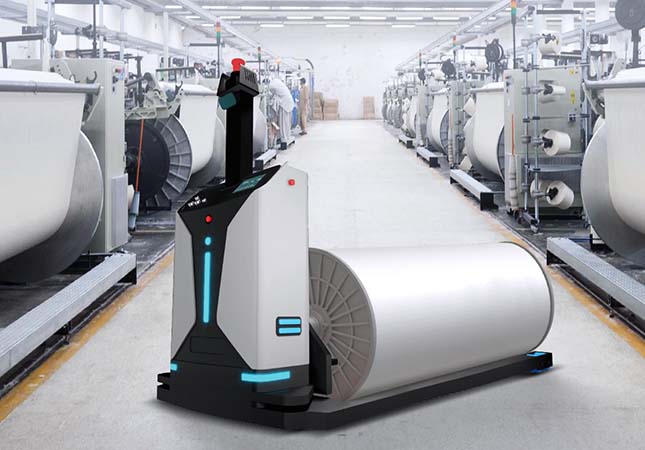The textile factory functions as a multifaceted establishment, orchestrating a multitude of machinery and processes to sustain continuous production. Its trajectory of progress primarily revolves around high-speed equipment, automation, and the consolidation of semi-finished products into sizable rolls for packaging. The movement of these intermediate goods between diverse procedures entails labor-intensive and physically arduous endeavors. According to statistics, the transportation operations within a typical textile factory demand approximately 20% of the total workforce. Moreover, the labor allocated to loading and unloading during transportation exceeds that of conveying by more than 2.5 times, underscoring the remarkable physical exertion associated with these responsibilities.

The textile factory deals with raw materials, finished products, and semi-finished products that possess distinct attributes such as low density, fluffy and soft texture, and delicate and unstable shape. Their transportation necessitates utmost care to prevent damage, forbidding arbitrary handling, collisions, or friction. Hence, most semi-finished products in textile factories are transported in rolled form. The containers employed for rolling, such as bobbins, yarn tubes, spools, and cloth rods, undergo recycling and circulation. Furthermore, the semi-finished products in textile factories not only exhibit substantial quantity and volume but also require adaptable transportation routes based on the manufactured product types, subject to potential changes. These characteristics and requirements introduce certain complexities and challenges to transportation operations in the textile industry.
In recent years, automation has emerged as a significant focus in Indian textile machinery, driven by textile manufacturers in this fiercely competitive industry who strive to enhance efficiency and reduce costs. Automation in the textile industry entails the utilization of technology and machines to perform tasks formerly executed by humans. This encompasses a wide range of activities, including spinning, weaving, finishing, and packaging. The advent of automation has ushered in numerous transformations in the textile industry, presenting both advantages and disadvantages that warrant careful consideration.
1. Enhanced Efficiency
Automation in the textile machinery offers a prominent advantage of heightened efficiency. Automated systems operate at a significantly accelerated pace compared to manual labor, enabling manufacturers to augment their production capacity and minimize task completion time. Consequently, substantial cost savings are realized as manufacturers can generate a greater volume of goods within a shorter timeframe while simultaneously reducing labor requirements.
In addition to efficiency improvements, automation also elevates the quality of textile products. Automated systems exhibit superior precision and consistency compared to manual labor, resulting in decreased defects and an overall enhancement in finished product quality. This advantage holds particular significance in the textile industry, where even minor imperfections can have a considerable impact on the final product's excellence.
2. Enhanced Safety
Automation in the textile industry contributes to improved safety conditions. By eliminating physically demanding or hazardous tasks, automated systems mitigate the risk of worker injuries. Consequently, working conditions are enhanced, creating a safer environment for employees.
Multiple pivotal technologies drive the adoption of automation in the Indian textile industry. Foremost among these is robotic automation, enabling comprehensive task automation encompassing material handling, cutting, and sewing. Robotic automation proves particularly advantageous in the textile sector, empowering manufacturers to handle large material volumes while maintaining high precision and consistency.
Machine learning, another crucial technology, equips machines with the ability to learn and adapt to new tasks and environments over time. This capability enhances the efficiency and effectiveness of automation systems, as machines learn from mistakes and continuously refine their performance.
Beyond these technologies, the Indian textile industry employs various other tools and systems for automation. Computer-aided design (CAD) systems, for instance, enable manufacturers to utilize computer simulations for the design and testing of new products. Additionally, advanced sensors and monitoring systems contribute to improved efficiency and accuracy in automation processes.
SUNTECH Textile Machinery has the range of products encompasses almost all fabric types, including but not limited to pinking machine, loom machine, weaving machine, beam truck, fabric cutting machine, motorized beam trolley, beam storage, and fabric inspection machine. SUNTECH Textile Machinery continues to lead the textile industry with our innovative approach and extensive experience. Welcome quotes and cooperation opportunities from you!




